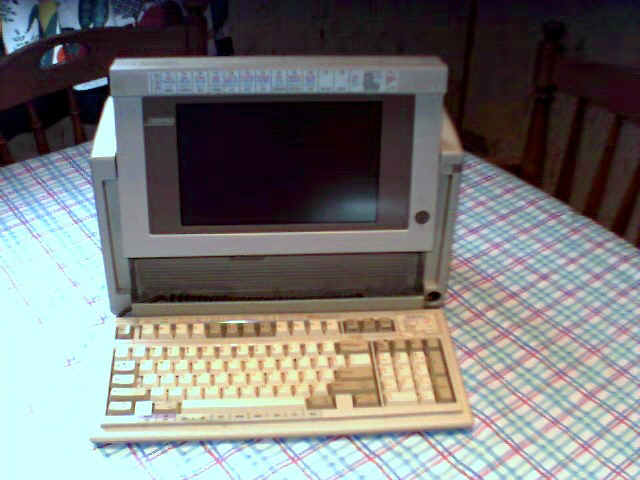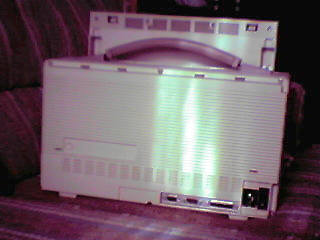
Compaq Portable III

Open for business....
The Compaq Portable III was definitely one of the finest portable computers of its day. The one pictured above is the base version of the computer. The basic configuration includes 640K of RAM memory, a 20MB internal hard drive, an internal 5.25" , 1.2MB high density floppy drive, and the adjustable gas plasma display. Also included are parallel, serial, and RGB monitor ports. The computer is AC powered. The base version of the Portable III (Model 20), had a list price of $4,999.00. Another version, the Model 40 (40 MB hard drive) was available at $5,799.00 DOS 3.3 was an extra $120.00. My unit has an optional 2400 baud internal modem. I don't know the price of that modem, but they listed the slower 1200 baud version at $349.00. The Compaq was a top flight computer and the price was a little steep even for that time. Prices listed were in effect in 1988.
The original Compaq Portable was a fairly large unit that looked like a portable sewing machine when it was all packed up. The machine was followed by the Compaq Portable II. This second generation machine was nearly as heavy as the original Portable, but had trimmer dimensions and the original machines' 8088 processor was upgraded to a 8 Mhz 80286 processor. This brings us up to the introduction of the Portable III. For most uses, this was a much better machine. Probably the most noticeable drawback for some users was the Portable III lacked internal expansion ports. Compaq offered an external expansion unit that could hold two full-length expansion cards. The unit attached to the rear of the computer and listed for $199.00.
The Compaq Portable III had been improved in several ways over the earlier machines. First of all, I would say it is roughly half the size of the original Portable. Secondly, though not exactly a lightweight, (at 20 lbs.), it was at least 6 lbs. lighter than the earlier designs. The footprint of the "lunch box" style case occupies about half the space of the older designs, or a traditional desktop computer. The reductions in size and weight made it much less of a chore to shuttle the computer between home and the office.

Rear View
The good news is that the Portable III performed as well as most decent desktop computers. The 12 Mhz 80286 was fully twice as fast as the original IBM PC/AT and capable of running most applications. The RAM could be expanded all the way up to 6.6MB. Last, but certainly not least, the gas plasma display was quite useable. The screen had a maximum resolution of 640 x 400. It was much easier to read than most LCD screens available at the time. And the thin folding screen was largely responsible for the size and weight reductions in the newer machine.
I like these machines very much. Unfortunately, mine is marginally useful due to a memory problem. It only can see 512K of the 640K installed. In addition, some programs deliver errors because they are trying to use the 128K of addresses that aren't working. But I can plug a phone line into the internal modem, fire up my DOS terminal program (ProComm) and log onto the Greater Detroit FreeNet and surf the Internet with it, (text mode, of course). A good friend of mine, Terry Y., picked this one up for me. He bought one for himself too, but his has the external expansion bays, a 40MB drive, and extended memory. These are nice machines and I never really had a problem with using DOS. Maybe someday I'll find a little nicer example of this computer, but I'm still glad to have one of these gems in my little collection.
Update: July 1999
I found another "orphaned" Portable III in a Salvation Army "as-is" store. Unfortunately I couldn't afford the $50 asking price. They had just got it in, but the keyboard had already grown legs and disappeared. It is essential to have the original keyboard if you are going to use these machines as a portable. The keyboard protects the screen when the machine is packed up for travel. It was in a neat carrying bag and was fully functional when I connected a keyboard to the machine. It has 640K RAM and a 20MB hard disk just like my first Portable III. Anyway, it went down to $38 a week later, but the carrying bag was gone too! Finally, about 10 days later, they were blowing out computer "parts" for 99 cents. I bought the computer (minus keyboard) for only $1.05 after they added on Michigan sales tax!
When I got the computer home it no longer would boot up to the hard drive. Somebody had managed to reset the hard drive type. The CMOS setup thought it had a 40 MB and a 20 MB hard drive. I had to run a setup program to let it know it had a 20 MB (Type 2) hard disk. I also used the keyboard from the first Portable III with this machine to make it fully functional again. The only thing I need to do is put the programs I want on the hard drive. I should have a good time tinkering with my new toy. I am keeping the first Portable III for spare parts.